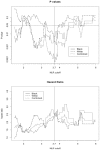The Pretreatment Neutrophil/Lymphocyte Ratio Is Associated with All-Cause Mortality in Black and White Patients with Non-metastatic Breast Cancer
- PMID: 27064712
- PMCID: PMC4815293
- DOI: 10.3389/fonc.2016.00081
The Pretreatment Neutrophil/Lymphocyte Ratio Is Associated with All-Cause Mortality in Black and White Patients with Non-metastatic Breast Cancer
Abstract
The pretreatment neutrophil/lymphocyte ratio (NLR), derived from differential white blood cell counts, has been previously associated with poor prognosis in breast cancer. Little data exist, however, concerning this association in Black patients, who are known to have lower neutrophil counts than other racial groups. We conducted a retrospective cohort study of 236 Black and 225 non-Hispanic White breast cancer patients treated at a single institution. Neutrophil and lymphocyte counts were obtained from electronic medical records. Univariate and multivariate Cox regression models were used to determine hazard ratios (HRs) and 95% confidence intervals (95% CIs) of all-cause mortality and breast cancer-specific mortality in relation to pretreatment NLR. Overall, there were no associations between an elevated pretreatment NLR (NLR ≥3.7) and all-cause or breast cancer-specific mortality. Among patients without metastasis at the time of diagnosis, an elevated pretreatment NLR was independently associated with all-cause mortality, with a multivariable HR of 2.31 (95% CI: 1.10-4.86). Black patients had significantly lower NLR values than White patients, but there was no evidence suggesting racial heterogeneity of the prognostic utility of NLR. Pretreatment NLR was an independent predictor of all-cause mortality but not breast cancer-specific mortality in non-metastatic breast cancer patients.
Keywords: Black patients; White patients; all-cause mortality; breast cancer; neutrophil/lymphocyte ratio.
Figures



Similar articles
-
Neutrophil-lymphocyte ratio and platelet-lymphocyte ratio as prognostic factors in non-metastatic breast cancer patients from a Hispanic population.Breast Dis. 2017;37(1):1-6. doi: 10.3233/BD-160251. Breast Dis. 2017. PMID: 28035906
-
The Peripheral Blood Neutrophil-To-Lymphocyte Ratio Is Superior to the Lymphocyte-To-Monocyte Ratio for Predicting the Long-Term Survival of Triple-Negative Breast Cancer Patients.PLoS One. 2015 Nov 18;10(11):e0143061. doi: 10.1371/journal.pone.0143061. eCollection 2015. PLoS One. 2015. PMID: 26580962 Free PMC article.
-
Pretreatment neutrophil-to-lymphocyte ratio is correlated with response to neoadjuvant chemotherapy as an independent prognostic indicator in breast cancer patients: a retrospective study.BMC Cancer. 2016 May 19;16:320. doi: 10.1186/s12885-016-2352-8. BMC Cancer. 2016. PMID: 27198767 Free PMC article.
-
Prognostic Significance of Pretreatment Neutrophil-to-Lymphocyte Ratio, Platelet-to-Lymphocyte Ratio, or Monocyte-to-Lymphocyte Ratio in Endometrial Neoplasms: A Systematic Review and Meta-analysis.Front Oncol. 2022 May 16;12:734948. doi: 10.3389/fonc.2022.734948. eCollection 2022. Front Oncol. 2022. PMID: 35651788 Free PMC article.
-
Prognostic value of pretreatment neutrophil-to-lymphocyte ratio in renal cell carcinoma: a systematic review and meta-analysis.BMC Urol. 2020 Jul 6;20(1):90. doi: 10.1186/s12894-020-00665-8. BMC Urol. 2020. PMID: 32631294 Free PMC article.
Cited by
-
Predictive value of lymphocyte-to-monocyte ratio in the preoperative setting for progression of patients with breast cancer.BMC Cancer. 2018 Nov 19;18(1):1137. doi: 10.1186/s12885-018-5051-9. BMC Cancer. 2018. PMID: 30453914 Free PMC article.
-
The neutrophil-to-lymphocyte and platelet-to-lymphocyte ratios predict efficacy of platinum-based chemotherapy in patients with metastatic triple negative breast cancer.Sci Rep. 2018 Jun 7;8(1):8703. doi: 10.1038/s41598-018-27075-z. Sci Rep. 2018. PMID: 29880896 Free PMC article. Clinical Trial.
-
Association of Neutrophil-to-Lymphocyte Ratio With Mortality and Cardiovascular Disease in the Jackson Heart Study and Modification by the Duffy Antigen Variant.JAMA Cardiol. 2018 Jun 1;3(6):455-462. doi: 10.1001/jamacardio.2018.1042. JAMA Cardiol. 2018. PMID: 29801037 Free PMC article.
-
Development and validation of a Comprehensive Hematological Scoring System for predicting overall survival in patients with soft tissue sarcomas: a comparison with NLR and PLR.Front Oncol. 2025 Aug 1;15:1505485. doi: 10.3389/fonc.2025.1505485. eCollection 2025. Front Oncol. 2025. PMID: 40823074 Free PMC article.
-
Prognostic value of lymphocyte-to-monocyte ratio among Asian lung cancer patients: a systematic review and meta-analysis.Oncotarget. 2017 Aug 28;8(66):110606-110613. doi: 10.18632/oncotarget.20574. eCollection 2017 Dec 15. Oncotarget. 2017. PMID: 29299172 Free PMC article.
References
-
- American Joint Committee on Cancer. AJCC Cancer Staging Handbook: From the AJCC Cancer Staging Manual. New York: Springer; (2002).
LinkOut - more resources
Full Text Sources
Other Literature Sources

